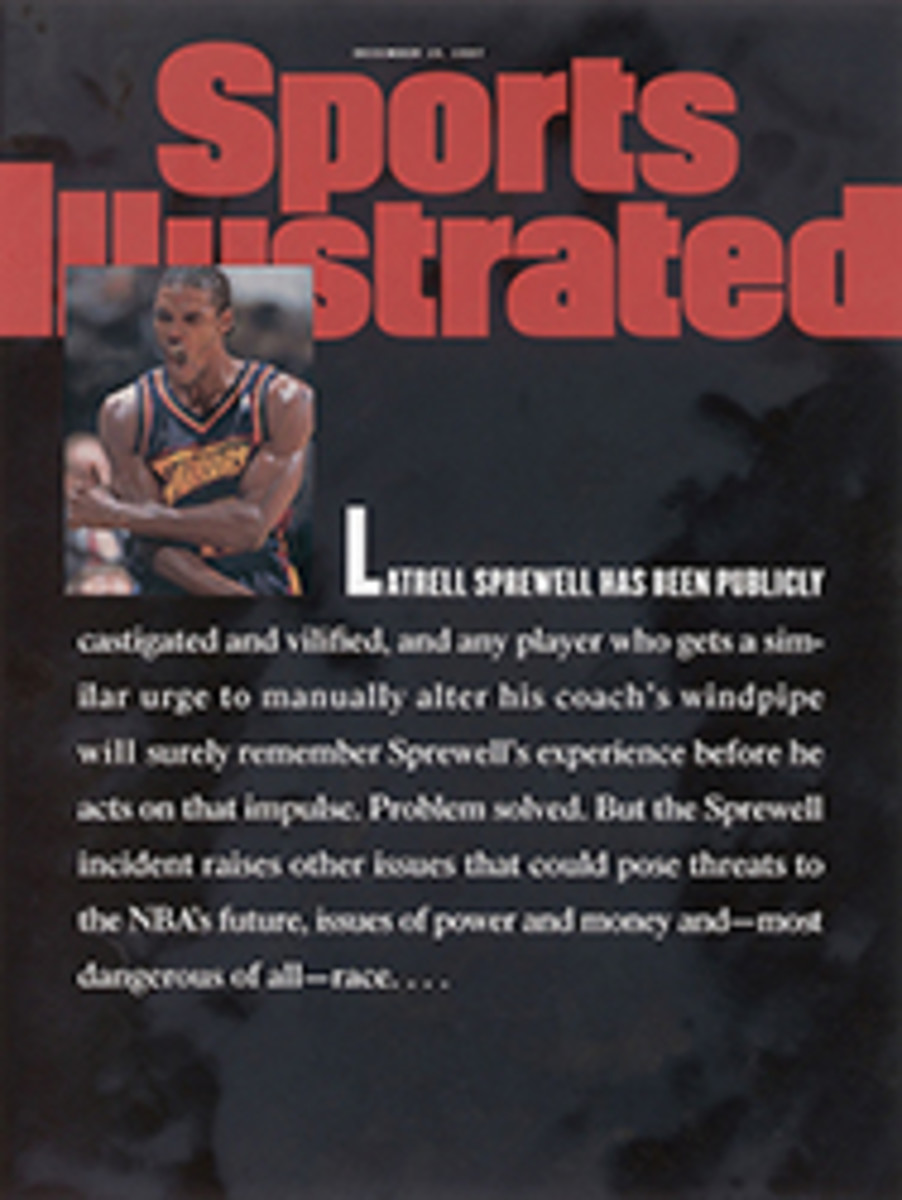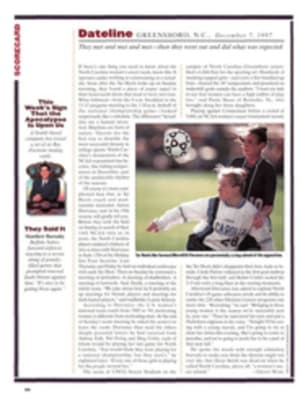
HOLMGREN, O.J. AND ME MEMORIES OF TEAMMATES AND FOES IN SAN FRANCISCO, CIRCA 1964, PUT LIFE IN PERSPECTIVE
Whenever football season rolls around, I think about the first
time I met Green Bay Packers coach Mike Holmgren. He extended
his hand to me, and I tried to break his arm. That was in 1964,
on Lincoln High's football field in San Francisco. Holmgren was
an all-city quarterback for Lincoln, and I was an anonymous
defensive tackle for rival Balboa High.
Holmgren was rushing out of the pocket, and I had been allowed
to slip past his center--one of the few mistakes made by
Lincoln's line that early October afternoon. Big Mike
straight-armed me in the face, and I yanked the arm and quickly
brought him to the ground. Then we exchanged shoves and nasty
words.
It was the third game of the 1964 season. Balboa and Lincoln
each had won its first two games; Balboa had beaten the '63 city
champion, Washington High, 13-6 the week before. Lincoln,
meanwhile, was a 10-point favorite with bookmakers on Mission
Street, mostly because of Big Mike's leadership, a strong
offensive line and two fast running backs.
The opposing quarterbacks typified the two schools' cultural
differences. Holmgren was big, tall and blond; Balboa's Juan
Valero, the son of Mexican immigrants, was shorter, darker, wiry
and muscular. Valero, who was also Balboa's co-captain, was
tough on the field but a supportive comrade in training and a
warm friend. "Call me anytime, and I'll be there," he said when
I first met him. "And call me Jon--that's my name in English!"
While only a few miles separated Balboa and Lincoln, the schools
were worlds apart. Lincoln had a fairly modern campus spread
over several blocks in the outer Sunset District, named for its
proximity to Ocean Beach. Balboa was built in the traditional
Spanish style of architecture that dominated the Mission
District in the decades after the 1906 earthquake and fire.
Balboa drew students from the working-class south-central and
southeastern sections of San Francisco. At that time Balboa was
one of the biggest high schools west of Chicago. There were so
many baby-boomer students that senior classes graduated in both
June and January.
In 1964 the Balboa football team got off to its best start since
its championship season of 1957. In the opener we shut out
Galileo 28-0. We ran up 416 yards, while Galileo gained
139--most of them on rushes by a promising running back named
O.J. Simpson. His thunderous charges left me with neck pains
that still require weekly attention from a chiropractor. Valero
had given me advance warning. "I grew up with Simpson on Potrero
Hill," he said. "He'll run right over you if you don't move fast
and hang on."
After handling Galileo we beat Washington, but when we played
Lincoln, it quickly became apparent that our team could not
defend against Holmgren's powerful arm and eagle eye. At the
half Lincoln led 13-0. In the locker room Valero tried to pump
up our spirits while coach Archie Chagonjian and his assistant,
George White, outlined second-half strategy. But when I scanned
the faces of my teammates, all I could read was defeat. The
bubble had burst. Holmgren and Lincoln were better, faster,
stronger, smarter. When we returned to the field we'd have to
fight for survival.
Lincoln continued to score, and when Balboa got the ball, the
scenario usually was run-run-pass-punt. Toward the middle of the
third quarter, Valero handed off to halfback Milton Frank, and a
blitz left them both on the ground. The overly exuberant Lincoln
defenders made late hits and piled on. When one of the
linebackers rose from the pile by stepping on Frank's hand, two
other Balboa backs, Victor Yanez and Leroy Caracter, protested.
Several Lincoln linemen jumped them, and a free-for-all erupted.
Both benches emptied. Players were swinging their fists, pushing
and kicking. Holmgren shoved me, and I tagged him in the ribs.
Some Balboa players grabbed a bench and charged into Lincoln
players, stunning them.
Lincoln's field, unfortunately, had seating on only one side, so
spectators from both schools, seated near each other, began
brawling, too. Several people were stabbed. Police tore through
the stands, rousting troublemakers and arresting the most
vicious of the attackers. The melee went on for at least 20
minutes and is still remembered as one of the worst high school
riots in city history.
At first we doubted that the game would continue, but after
assurances from captains Valero and Holmgren, the teams ran back
onto the field. There the football slaughter continued, and
Lincoln won 51-3, having racked up 460 yards in offense.
Washington eventually won the 1964 city championship. Lincoln
finished with a 7-2 record, and Balboa ended the season 4-5,
never having recovered from the beating by Lincoln.
As the decades passed I never forgot Holmgren, as one never
forgets anyone who ran over him in life. I often talk about that
Lincoln-Balboa game when I see old high school friends, and we
compare it to other events in our lives, seeking some kind of
cosmic meaning. "Just one of those things," we eventually agree,
believing that the real value of our athletic experience at
Balboa was having learned teamwork.
"What I've loved about playing football at Balboa," said Valero
at a team meeting at the end of the '64 season, "is that we have
nearly 40 different guys--black, white, Mexican, Irish, Italian,
Filipino, Puerto Rican, even a Cajun--who work as a team and get
along together. This is something that we can take with us all
through life: Knowing how to work with and get along with all
kinds of different people. That's what we've really learned on
this team."
I lost track of Holmgren after he and Simpson made the all-city
prep team in 1964. While Simpson went on to win the Heisman
Trophy at Southern Cal in 1968 and star in the NFL, Holmgren
faded from memory. But I knew exactly what happened to my
teammates.
Valero, Frank, Yanez, Caracter and I went into the Army, as did
many of our 1964 teammates. Most of us couldn't afford college,
even if we had been able to get into one. There were no football
scholarships for the Balboa team of 1964.
Yanez and I were drafted on the same day in 1968 and went to
basic training together at Fort Lewis, Wash. Yanez had become
Balboa's quarterback in 1965 after top jayvee prospect Rodney
Garcia was gunned down in a drive-by shooting a block away from
campus. The killer randomly fired at a crowd of us eating lunch
at a drive-in restaurant, killing Rodney, wounding another
student and scattering the rest of us.
The last time I saw Yanez, we were at the rifle range. "Well,
Toland," he said, "I guess we're on a winning team this time." A
year later, already a decorated infantry sergeant, Yanez died in
a jungle in Vietnam.
Holmgren, as it turned out, coached high school football until
1981. When he landed a spot as an assistant coach at San
Francisco State, our paths crossed again. I had just been hired
there as a part-time journalism lecturer.
We talked for a few minutes one day near the football field. I
told him that after my discharge from the Army, I had hitchhiked
around the country, then worked my way through college. We were
both a little envious of Simpson's success. I couldn't admit to
Holmgren how lousy he had made me feel back in 1964.
When Holmgren took Balboa apart that day, everyone on our team
thought that he was just another high school kid and that we had
been beaten badly by just another peer. It would have softened
the blow quite a bit to have known that one day Holmgren would
become head coach at Green Bay and eventually lead his team to
victory in Super Bowl XXXI. When Brett Favre and the rest of
Holmgren's crew sent New England packing last January, I
couldn't help thinking of how Holmgren had cut his teeth on us
in 1964.
I watched last winter's Super Bowl with my 16-year-old son,
John, and told him the story of Lincoln versus Balboa, Holmgren
versus Valero. John asked me to dig out my old yearbook to see
if there might be a photo of me chasing Big Mike or maybe even
O.J. There wasn't.
Instead, one photo on the varsity football pages caught my eye.
It was the only one that had been signed. It was of number 10,
Jon Valero, running with the ball against Sacred Heart High. He
had written on it simply: "Remember Me!!" Valero, a decorated
infantry sergeant, like Yanez, also was slain in Vietnam.
If not for Holmgren, I might not have opened that dusty old
yearbook, and I might not have passed Valero's legacy on to my
son: "Move fast, hang on"--and celebrate diversity.
Jim Toland is a freelance writer and corporate communications
consultant in Sausalito, Calif.
TWO COLOR ILLUSTRATIONS: ILLUSTRATIONS BY MARGOT THOMPSON [Drawing of eye looking at signed yearbook photograph; football player running across field of clasped hands]

